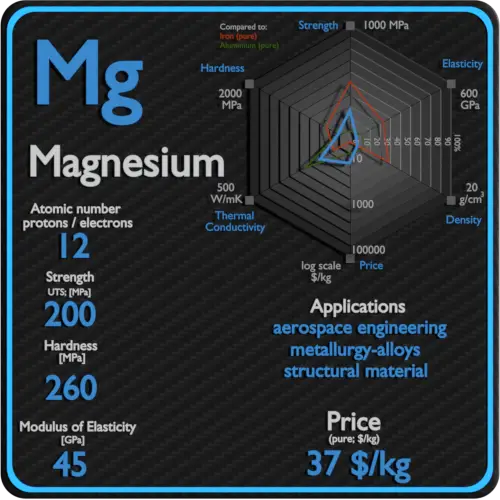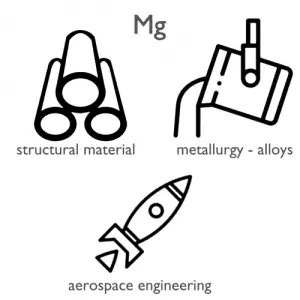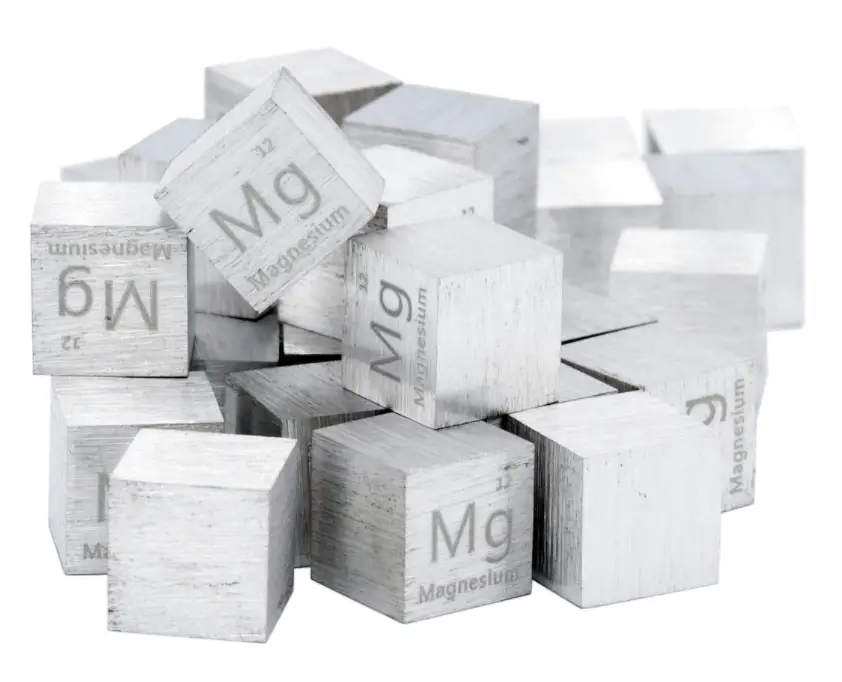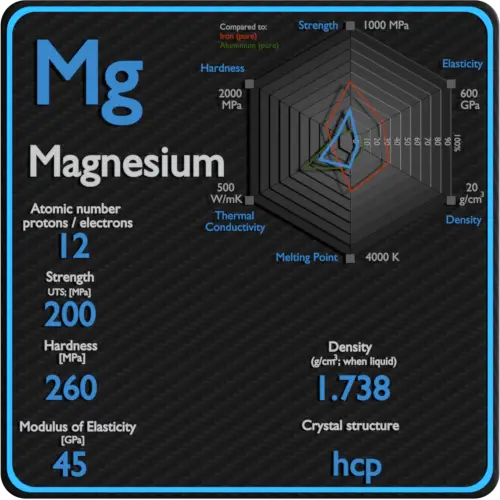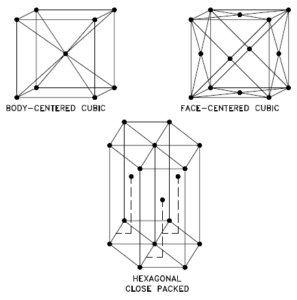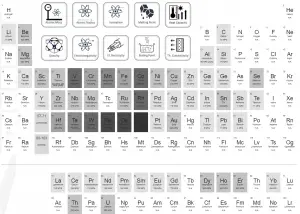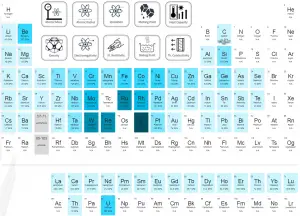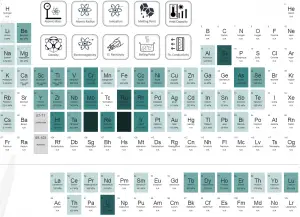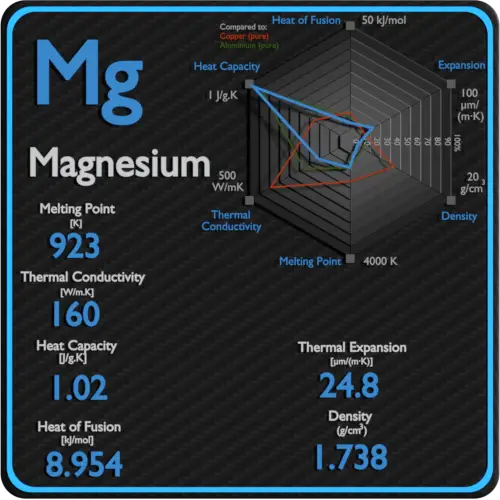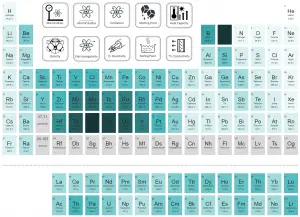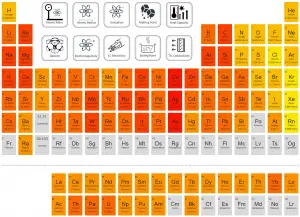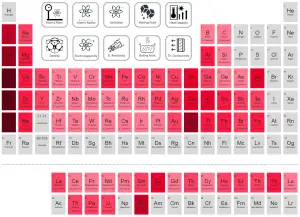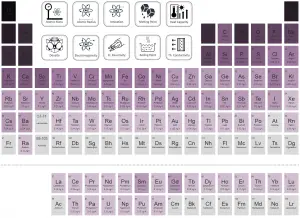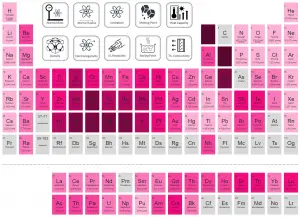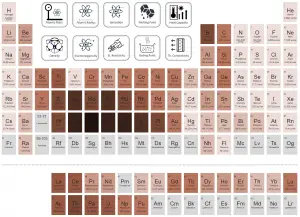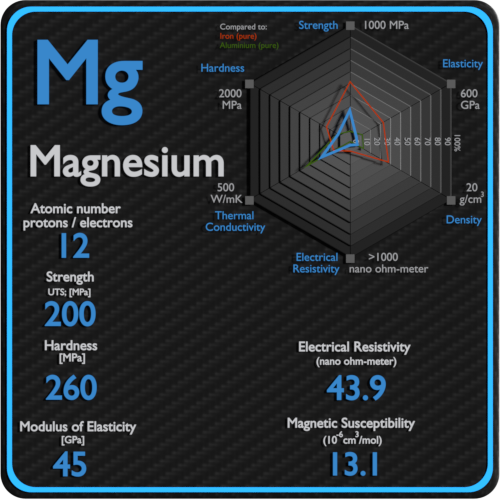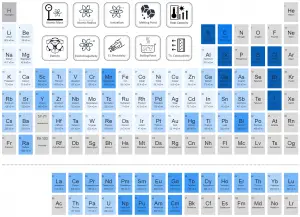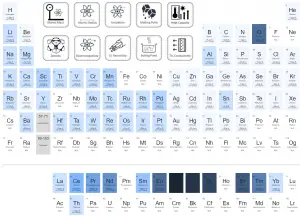About Magnesium
Magnesium is a shiny gray solid which bears a close physical resemblance to the other five elements in the second column (group 2, or alkaline earth metals) of the periodic table: all group 2 elements have the same electron configuration in the outer electron shell and a similar crystal structure.
Summary
| Element | Magnesium |
| Atomic number | 12 |
| Element category | Alkaline Earth Metal |
| Phase at STP | Solid |
| Density | 1.738 g/cm3 |
| Ultimate Tensile Strength | 200 MPa |
| Yield Strength | N/A |
| Young’s Modulus of Elasticity | 45 GPa |
| Mohs Scale | 2.5 |
| Brinell Hardness | 260 MPa |
| Vickers Hardness | N/A |
| Melting Point | 649 °C |
| Boiling Point | 1090 °C |
| Thermal Conductivity | 156 W/mK |
| Thermal Expansion Coefficient | 24.8 µm/mK |
| Specific Heat | 1.02 J/g K |
| Heat of Fusion | 8.954 kJ/mol |
| Heat of Vaporization | 127.4 kJ/mol |
| Electrical resistivity [nanoOhm meter] | 43.9 |
| Magnetic Susceptibility | +13.1e-6 cm^3/mol |
Applications of Magnesium
Magnesium is the third-most-commonly-used structural metal, following iron and aluminium.[35] The main applications of magnesium are, in order: aluminium alloys, die-casting (alloyed with zinc), removing sulfur in the production of iron and steel, and the production of titanium in the Kroll process. Magnesium alloys are used in a wide variety of structural and nonstructural applications. Structural applications include automotive, industrial, materials-handling, commercial, and aerospace equipment. Magnesium alloys are used for parts that operate at high speeds and thus must be light weight to minimize inertial forces. Commercial applications include hand-held tools, laptops, luggage, and ladders, automobiles (e.g., steering wheels and columns, seat frames, transmission cases). Magnox (alloy), whose name is an abbreviation for “magnesium non-oxidizing”, is 99% magnesium and 1% aluminum, and is used in the cladding of fuel rods in magnox nuclear power reactors.
Production and Price of Magnesium
Raw materials prices change daily. They are primarily driven by supply, demand and energy prices. In 2019, prices of pure Magnesium were at around 37 $/kg.
Magnesium is today obtained mainly by electrolysis of magnesium salts obtained from brine, and is used primarily as a component in aluminium-magnesium alloys, sometimes called magnalium or magnelium. World production was approximately 1,100 kt in 2017, with the bulk being produced in China (930 kt) and Russia (60 kt). Magnesium is less dense than aluminium, and the alloy is prized for its combination of lightness and strength.
Source: www.luciteria.com
Mechanical Properties of Magnesium
Strength of Magnesium
In mechanics of materials, the strength of a material is its ability to withstand an applied load without failure or plastic deformation. Strength of materials basically considers the relationship between the external loads applied to a material and the resulting deformation or change in material dimensions. In designing structures and machines, it is important to consider these factors, in order that the material selected will have adequate strength to resist applied loads or forces and retain its original shape. Strength of a material is its ability to withstand this applied load without failure or plastic deformation.
For tensile stress, the capacity of a material or structure to withstand loads tending to elongate is known as ultimate tensile strength (UTS). Yield strength or yield stress is the material property defined as the stress at which a material begins to deform plastically whereas yield point is the point where nonlinear (elastic + plastic) deformation begins.
See also: Strength of Materials
Ultimate Tensile Strength of Magnesium
Ultimate tensile strength of Magnesium is 200 MPa.
Yield Strength of Magnesium
Yield strength of Magnesium is N/A.
Modulus of Elasticity of Magnesium
The Young’s modulus of elasticity of Magnesium is 45 GPa.
Hardness of Magnesium
In materials science, hardness is the ability to withstand surface indentation (localized plastic deformation) and scratching. Brinell hardness test is one of indentation hardness tests, that has been developed for hardness testing. In Brinell tests, a hard, spherical indenter is forced under a specific load into the surface of the metal to be tested.
Brinell hardness of Magnesium is approximately 260 MPa.
The Vickers hardness test method was developed by Robert L. Smith and George E. Sandland at Vickers Ltd as an alternative to the Brinell method to measure the hardness of materials. The Vickers hardness test method can be also used as a microhardness test method, which is mostly used for small parts, thin sections, or case depth work.
Vickers hardness of Magnesium is approximately N/A.
Scratch hardness is the measure of how resistant a sample is to permanent plastic deformation due to friction from a sharp object. The most common scale for this qualitative test is Mohs scale, which is used in mineralogy. The Mohs scale of mineral hardness is based on the ability of one natural sample of mineral to scratch another mineral visibly.
Magnesium is has a hardness of approximately 2.5.
See also: Hardness of Materials
Magnesium – Crystal Structure
A possible crystal structure of Magnesium is hexagonal close-packed structure.
In metals, and in many other solids, the atoms are arranged in regular arrays called crystals. A crystal lattice is a repeating pattern of mathematical points that extends throughout space. The forces of chemical bonding causes this repetition. It is this repeated pattern which control properties like strength, ductility, density, conductivity (property of conducting or transmitting heat, electricity, etc.), and shape. There are 14 general types of such patterns known as Bravais lattices.
See also: Crystal Structure of Materials
Crystal Structure of Magnesium
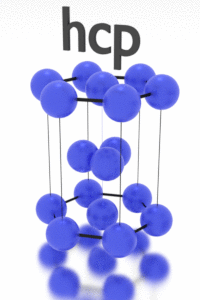
Thermal Properties of Magnesium
Magnesium – Melting Point and Boiling Point
Melting point of Magnesium is 649°C.
Boiling point of Magnesium is 1090°C.
Note that, these points are associated with the standard atmospheric pressure.
Magnesium – Thermal Conductivity
Thermal conductivity of Magnesium is 156 W/(m·K).
The heat transfer characteristics of a solid material are measured by a property called the thermal conductivity, k (or λ), measured in W/m.K. It is a measure of a substance’s ability to transfer heat through a material by conduction. Note that Fourier’s law applies for all matter, regardless of its state (solid, liquid, or gas), therefore, it is also defined for liquids and gases.
Coefficient of Thermal Expansion of Magnesium
Linear thermal expansion coefficient of Magnesium is 24.8 µm/(m·K)
Thermal expansion is generally the tendency of matter to change its dimensions in response to a change in temperature. It is usually expressed as a fractional change in length or volume per unit temperature change.
Magnesium – Specific Heat, Latent Heat of Fusion, Latent Heat of Vaporization
Specific heat of Magnesium is 1.02 J/g K.
Heat capacity is an extensive property of matter, meaning it is proportional to the size of the system. Heat capacity C has the unit of energy per degree or energy per kelvin. When expressing the same phenomenon as an intensive property, the heat capacity is divided by the amount of substance, mass, or volume, thus the quantity is independent of the size or extent of the sample.
Latent Heat of Fusion of Magnesium is 8.954 kJ/mol.
Latent Heat of Vaporization of Magnesium is 127.4 kJ/mol.
Latent heat is the amount of heat added to or removed from a substance to produce a change in phase. This energy breaks down the intermolecular attractive forces, and also must provide the energy necessary to expand the gas (the pΔV work). When latent heat is added, no temperature change occurs. The enthalpy of vaporization is a function of the pressure at which that transformation takes place.
Magnesium – Electrical Resistivity – Magnetic Susceptibility
Electrical property refers to the response of a material to an applied electric field. One of the principal characteristics of materials is their ability (or lack of ability) to conduct electrical current. Indeed, materials are classified by this property, that is, they are divided into conductors, semiconductors, and nonconductors.
See also: Electrical Properties
Magnetic property refers to the response of a material to an applied magnetic field. The macroscopic magnetic properties of a material are a consequence of interactions between an external magnetic field and the magnetic dipole moments of the constituent atoms. Different materials react to the application of magnetic field differently.
See also: Magnetic Properties
Electrical Resistivity of Magnesium
Electrical resistivity of Magnesium is 43.9 nΩ⋅m.
Electrical conductivity and its converse, electrical resistivity, is a fundamental property of a material that quantifies how Magnesium conducts the flow of electric current. Electrical conductivity or specific conductance is the reciprocal of electrical resistivity.
Magnetic Susceptibility of Magnesium
Magnetic susceptibility of Magnesium is +13.1e-6 cm^3/mol.
In electromagnetism, magnetic susceptibility is the measure of the magnetization of a substance. Magnetic susceptibility is a dimensionless proportionality factor that indicates the degree of magnetization of Magnesium in response to an applied magnetic field.
